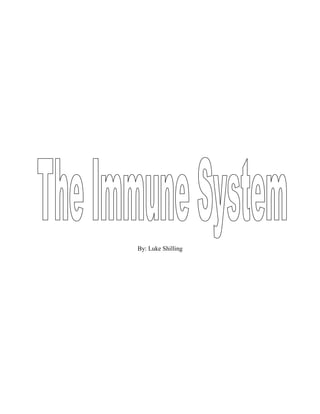
Immune system
- 1. By: Luke Shilling <br />The immune system an army of cells, tissues, and organs that fight off infected, nonfunctional microbes that can make you sick or cause disease. A microbe is a minute living organism such as bacteria, fungi, or parasites. There are two cell systems that are relied on to sustain efficiency throughout the immune system, both are affiliated with lymphocytes. “Lymphocytes are cells created in the body’s primary (bone marrow and thymus) and secondary (lymph nodes and spleen)” (Dodds 1). The B-Cell system is responsible for producing and distributing antibodies or protein molecules that act as an immune defense. “These antibodies provide an important defense mechanism against disease in healthy individuals but can become hyperactive or hypoactive in a variety of disease states. Hyperactive or increased levels of immunoglobulins (antibodies) can occur. Hypoactive or decreased levels of immunoglobulins can result from rare genetically based immunodeficiency states such as agammaglobulinemia or hypogammaglobulinemia” (Dodds 1). The T-Cells in the T-Cell system are the “coordinators” of the immune system (1). It is also the T-Cell’s job to respond to any part of the body that is abnormal. Cooperation of these two systems is essential to a healthy stable immune system.<br />In our world today there are many sicknesses that can severely infect or kill you. Your immune is there to fight off sicknesses. Examples of these sicknesses are HIV, malaria, and bubonic plague. The two I will be focusing on are bubonic plague and malaria. “Malaria is primarily transmitted through the bite of an infected female Anopheles” an Anopheles is a species of Mosquito (Fernandez 1). Symptoms of malaria are fever, chills, sweats, headaches, and fatigue. Malaria blocks communication between blood cells. Every year 300 million to 500 million cases of malaria occur, and only 2 million are fatal. A vast amount of the fatalities from malaria are children. Adults living in malaria infested areas become immune to the infection, but developing children do not. Natural immunity occurs when the person’s body balances his/her immune system with the parasites. Adults also grow “mechanisms” that kill parasites (Tsakonas). Malaria is most common in Africa and northern South America. Malaria is also found on the Indian Subcontinent. Currently in malaria infested precautionary measures have been taken and now people sleep with bed nets soaked with mosquito repellent. An interesting fact is that “thirty percent of child deaths from malaria could have been prevented had they been sleeping with bed nets” (Perlin). “An ideal malaria vaccine would prevent infection by stimulating the immune system to destroy all parasites, whether free-swimming in the blood, in the liver, or in red blood cells” (Perlin). Malaria is a serious problem that many people’s immune systems cannot fight off. There is a bright future for those living in malaria infested areas, as doctors are trying to find a vaccine. <br />Another sickness that severely harms the human body is bubonic plague. Also known as “Black Death” the bubonic plague is spread through infected rodents and fleas. These rats and fleas spread to humans when a human is bitten by an infected flea, or come in contact with an infected rodent. Bubonic plague is a “potentially fatal” bacterial infection (Kugler). Symptoms of bubonic plague are chills, headache, fever, and discoloration of the skin. Bubonic plague cases were mostly seen in the middle ages. 1000 to 3000 cases are seen each year. Bubonic plague is a big reason why the Mongol empire collapsed because so many people were affected. Bubonic plague today is not as much of a problem as it was many years ago because of modern medicine. <br />Bubonic plague is an infection that can harshly affect your immune system. When you have bubonic plague you will start to see little swollen glands called buboes. These buboes can be very painful at times. Bubonic plague is very dangerous to you externally and internally. <br />Works Cited<br />Dodds, Jean. quot; Immune System.quot; Lecture. 938 Stanford Street, Santa Monica. Www.critterchat.net. Critter Chat, 2002. Web. 8 Mar. 2010. <http://www.critterchat.net/immune.htm>.<br />Fernandez, MC. quot; E Medicine.quot; Lecture. Www.medscape.com. Web MD, 2010. Web. 8 Mar. 2010. <http://emedicine.medscape.com/article/784065-overview>.<br />Tsakonas, Artavanis K. quot; The War between the Malaria Parasite and the Immune System: Immunity, Immunoregulation and Immunopathology.quot; Www.pubmed.gov. U.S Library of Medicine, Aug. 2003. Web. 4 Apr. 2010. <http://www.ncbi.nlm.nih.gov/pubmed/12869017>.<br />Perlin, David. quot; Malaria.quot; 2002. Web. 4 Apr. 2010. <http://www.infoplease.com/cig/dangerous-diseases-<br />epidemics/prevention-cure.html>.<br />Kugler, Mary. quot; Bubonic Plague.quot; About.com. 2 Feb. 2009. Web. 4 Apr. 2010. <http://rarediseases.about.com/cs/bubonicplague/a/111602.htm>.<br />quot; CDC Plague Homepage.quot; 25 July 2009. Web. 4 Apr. 2010. <http://www.cdc.gov/ncidod/dvbid/plague/>.<br />